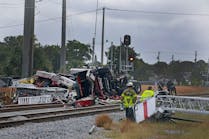Throughout history, many cultures have used smoke to communicate, including Native Americans, ancient Chinese and even modern Boy Scouts. Firefighters can also read smoke signals to determine fireground strategies and tactics.
David Dodson, a retired battalion chief from Colorado and owner of Response Solutions LLC, conducted a class called “Reading Smoke: 2012 Tactical Solutions” at this year’s Fire Department Instructors Conference in Indianapolis.
“Reading smoke can tell us what is happening now and, more importantly, what is going to happen in the future,” said Dodson, a 33-year veteran of the fire service who has been teaching the art of smoke reading at FDIC for years. “Reading smoke can tell us how big or intense a fire is, maybe where the fire is,” he said. “Watching how fast it is changing can tell if we have seconds or minutes before something happens.”
Color, speed and amount are all signals indicating what smoke is doing, Dodson said.
“If I have a lot of dark, black turbulent smoke, it means I’ve got a lot of orange in my future,” he said.
Because smoke is fuel, made up particulates, aerosols and gases, knowing what smoke is doing is significant in fighting fire, Dodson said.
The particulates are made up of carbon, dust and fibers. Aerosols are water vapor and hydrocarbons as materials “off-gas,” Dodson said. White smoke is often water vapor as the initial heating of any object begins and moisture is driven out. Hydrocarbon can be tars, soot and oils, all of which are very flammable and have a variety of ignition point temperatures, many of which are lower than what firefighters can perceive. The gases in fire include carbon monoxide, hydrogen cyanide, benzene and acrolein.
In addition to the composition of smoke, the color, volume, density and velocity are all important elements of reading smoke, Dodson said. He added that while flames are dramatic and draw firefighters' attention, smoke is the more important determinant in predicting the future of the fire. Flames are at the end of their potential, he said, whereas smoke shows where the real danger and fire potential lies.
A small building can be filled with smoke from a very small fire, even from cooking, but a big building filled with smoke means a big, deep-seated fire internally. It takes a significant event to fill up a big factory building, or box store with smoke. Therefore, smoke volume is important in determining the relative size of a fire, Dodson said.
Velocity of smoke is determined by comparison of smoke from various openings, Dodson said, adding that velocity can be used to determine fire location and amount of heat. Smoke that is slow and laminate means it has likely traveled some distance from the seat of the fire, but smoke that looks like it is boiling and keeps its energy as it leaves an opening is likely being driven by flames meaning the fire is close by, Dodson said.
Turbulent or supercharged smoke means extreme heat and radiant heat and is the most dangerous of all, especially if it’s very dense. That’s the kind of smoke that can ignite and flashover quickly because it is so loaded with fuel, he said, noting that the thicker the smoke the more explosive it becomes.
Color can also be an important factor in determining the future of a fire. Dodson said light white smoke can often mean material is off-gassing moisture and water vapor, meaning the fire is just starting to consume material. As a general rule, the darker the smoke the more volatile it is, Dodson said.
Brown smoke is usually a sign that untreated wood is burning, meaning the fire has grown from being a room and contents type event to a structural event where the rafters and building itself are burning, Dodson said.
Smoke can go from white to gray to black and mix depending on what’s burning and for how long and the thicker the smoke, the more explosive it becomes.
Dodson said fires exhibiting supercharged smoke are typically not survivable and doing search and rescue in those kinds of conditions present extraordinary risks with very little to gain.
Smoke that is exiting the structure from multiple openings with the same color and velocity means the fire is deep-seated.
There are a number of variables that factor into smoke reading like weather conditions and wind speed, he said.
Rate of change in color and volume can mean the fire is getting worse more quickly than anticipated, he said, noting that experience is the best way to learn smoke reading.
Above all else, Dodson said, firefighters and incident commanders need to use their best judgment when reading smoke and committing firefighters to assignments. Smoke reading is just one tool to help forecast what might happen to a fire and it is not absolute.
“We have to remember that reading smoke is an art, not really a science, although there is science involved,” Dodson said. “As an art, it’s something that has to be learned and practiced.”





